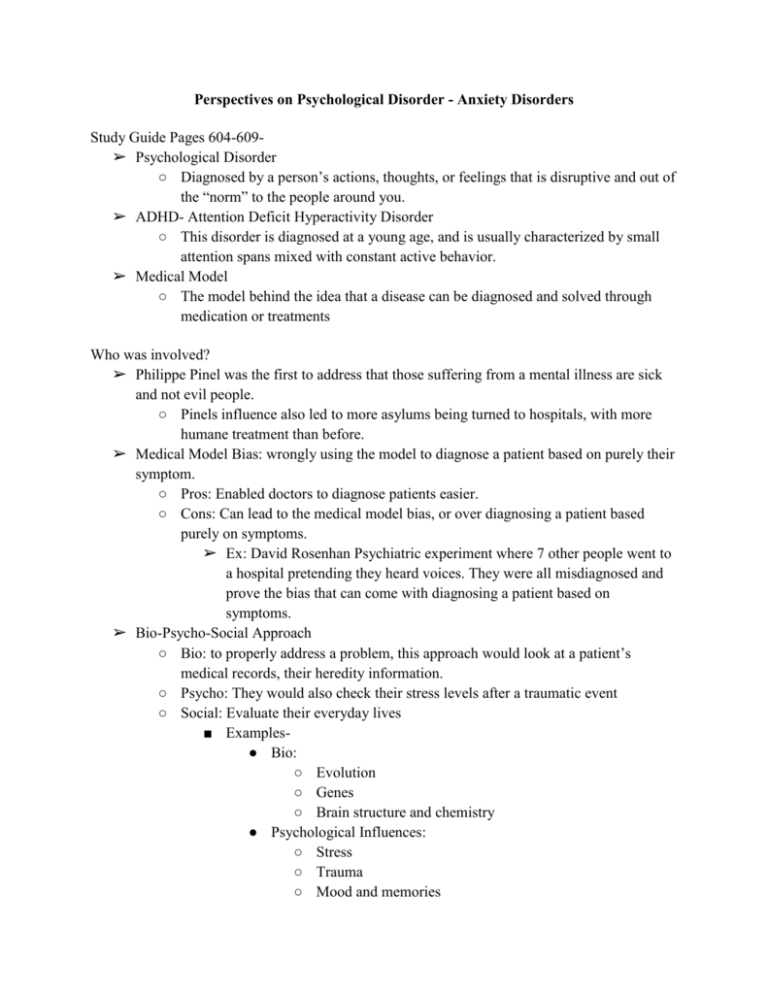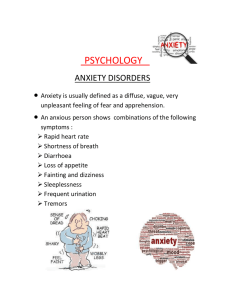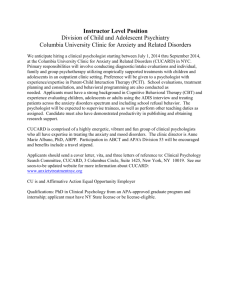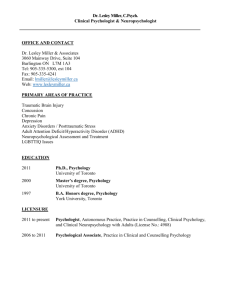Perspectives on Psychological Disorder
advertisement

Perspectives on Psychological Disorder - Anxiety Disorders Study Guide Pages 604-609➢ Psychological Disorder ○ Diagnosed by a person’s actions, thoughts, or feelings that is disruptive and out of the “norm” to the people around you. ➢ ADHD- Attention Deficit Hyperactivity Disorder ○ This disorder is diagnosed at a young age, and is usually characterized by small attention spans mixed with constant active behavior. ➢ Medical Model ○ The model behind the idea that a disease can be diagnosed and solved through medication or treatments Who was involved? ➢ Philippe Pinel was the first to address that those suffering from a mental illness are sick and not evil people. ○ Pinels influence also led to more asylums being turned to hospitals, with more humane treatment than before. ➢ Medical Model Bias: wrongly using the model to diagnose a patient based on purely their symptom. ○ Pros: Enabled doctors to diagnose patients easier. ○ Cons: Can lead to the medical model bias, or over diagnosing a patient based purely on symptoms. ➢ Ex: David Rosenhan Psychiatric experiment where 7 other people went to a hospital pretending they heard voices. They were all misdiagnosed and prove the bias that can come with diagnosing a patient based on symptoms. ➢ Bio-Psycho-Social Approach ○ Bio: to properly address a problem, this approach would look at a patient’s medical records, their heredity information. ○ Psycho: They would also check their stress levels after a traumatic event ○ Social: Evaluate their everyday lives ■ Examples● Bio: ○ Evolution ○ Genes ○ Brain structure and chemistry ● Psychological Influences: ○ Stress ○ Trauma ○ Mood and memories ● Social-Cultural Influences: ○ Roles ○ Expectations ○ Normality in society Study Guide Pages 614-618➢ Anxiety Disorders: ○ Generalized Anxiety Disorder: ■ Definition: Persistent and excessive worry that lasts at least 6 months ■ Symptoms: jittery, agitated, sleep deprived, difficulty concentrating because attention is forced on worry ■ Hard to avoid because it’s difficult to identify the cause ○ Panic Disorder ■ Definition: Unexpected, minute long episodes of intense dread ■ Fear that something horrible is going to happen ■ Symptoms: heart palpitations, shortness of breath, chest pain, sweating, dizziness, choking sensations ■ May be perceived as a heart attack, feels like you’re dying ○ Phobias ■ Definition: When you avoid certain objects, activities, or situations due to fear ● Specific Phobias: Anxiety due to specific things such as animals, insects, heights, blood, confinement ● Social Phobias: Anxiety due to certain social experiences; extreme shyness. It’s the fear of being judged by others or embarrassed, so you avoid speaking up, eating out, or leaving your house ● Complex Phobias: ○ Agoraphobia: People who have experienced multiple panic attacks before so they avoid situations in which escape might be difficult or there will be no available help ○ Obsession-Compulsion Disorder ■ Definition: Characterized by unwanted repetitive thoughts (obsessions) and/or actions (compulsions) ● Obsessions: uncontrollable thoughts or impulses that are persistent and cause anxiety ( ex: fear of germs) ● Compulsions: repetitive behaviors that help prevent anxiety (ex: constantly washing hands to avoid germs) ■ Crosses between normal and disorder when they persistently affect your everyday life ○ Post-Traumatic Stress Disorder ■ Definition: Anxiety from not being able to forget traumatic experiences ■ Symptoms: recurring haunting memories, nightmares, jumpy anxiety, exaggerated startle response, insomnia that linger for 4+ weeks after traumatic event ■ Greater one's emotional distress during trauma, the higher the risk for PTSD symptoms ● Post Traumatic Growth ● “benefit finding” from a traumatic event ● Richard Tedeschi and Lawrence Calhoun determined that the struggling with a crisis leads to an increased appreciation for life ● Ex: After one finds out they beat cancer, they develop more meaningful relationships, an increase in personal strength, and changed priorities Study Guide pages 610-613 ➢ Classifying Psychological Disorders ○ classification orders and describes symptoms ○ aims to describe a disorder ■ also to predict its future course, suggest appropriate treatment, and stimulate research ➢ DSM-IV-TR: American Psychiatric Association's Diagnostic and Statistical Manual of Mental Disorders ○ A widely used system for classifying psychological disorders ○ defines a diagnostic process and 16 clinical syndromes ○ includes psychotic disorders ➢ Critiques: ○ manual casts “too wide a net” bringing almost any kind of behavior within the compass of psychiatry ■ known as over diagnosing ○ number of disorders has increased ○ labels create preconceptions that guide our interpretations ➢ Labeling Psychological Disorders ○ clinicians labeled normal behavior as symptoms ○ led to misdiagnosing patients ➢ Labels Matter ○ people are understanding that psychological disorders are diseases of the brain and the stigma is lifting ○ people express the greatest sympathy for people whose disorders are gender atypical ■ (men suffering from depression or women suffering from alcohol dependence) ○ labels can bias perceptions of people ■ (ex: when teachers are told certain students are “gifted” they may act in ways that provoke the expected behavior) ○ labels can serve as self-fulfilling prophecies ➢ Stereotypes in the media ○ stereotypes linger in media portrayals of psychological disorders ○ often people are portrayed as objects of humor and ridicule ➢ Stereotypes in real life ○ in real life people with disorders are more likely to be the victims of violence ○ very little risk of violence or harm to a stranger from casual contact with someone who has a mental disorder ➢ Benefits of diagnostic labels ○ mental health professionals use labels to communicate about their cases ■ to comprehend underlying causes ■ to distinguish effective treatment programs ○ inform patient self-understanding ○ useful in research ■ explore causes and treatment of disorders Study Guide Pages 618-621Understanding Anxiety Disorders ➢ Learning Perspective ○ Fear Conditioning ■ A result of classical conditioning in which a stimulus is associated with a traumatic event. That stimulus is feared later because of it. ■ Two specific learning processes occur to allow this to happen: ● Stimulus generalization: a specific, sometimes situational stimulus is associated with a more general form of that stimulus. ● Reinforcement: maintains the phobias and compulsions after they happen. Avoiding or escaping a feared situation reduces anxiety, thus reinforces the phobic behavior through negative reinforcement. ○ Observational Learning ■ We learn fears by observing others’ fears through our observations. ○ Cognition ■ Our interpretations and irrational beliefs spur our own anxiety. ■ Hypervigilance is common, in which people become extremely aware of their surroundings and interpret them negatively because of it. ➢ Biological Perspective ○ Natural Selection ■ Humans are biologically prepared to fear the same threats faced by our ancestors. ● These fears are often labeled as ‘evolutionarily relevant stimuli,’ or the dangers faced by our ancestors. ● The compulsions associated with them are often exaggerated behaviors that contributed to our species survival in the past. ○ Genes ■ Some people are more likely to be disposed to a phobia after experiencing a traumatic event because of their genes. ■ Genes also influence disorders through the regulation of neurotransmitters. Certain neurotransmitters in certain quantities can influence the way by which we react to our situations. ○ The Brain ■ Many psychological disorders are the result of overactivity of certain areas in the brain that control our impulses and habitual behaviors. ● OCD: The anterior cingulate cortex (monitors our actions and checks for errors) is hyperactive ● Fear-learning: Result of ‘fear circuits’ within the amygdala ■ Drugs often act as a damper to the emotions or responses associated with an experience.










